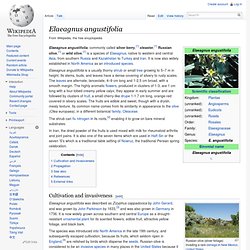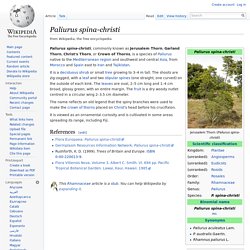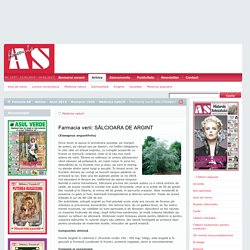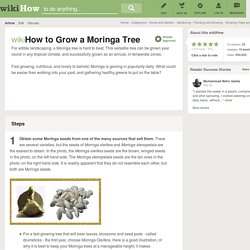

Frunza de smochin - Recunoasrerea arborilor dupa frunze - popescutraian. Imagine1496 - Recunoasterea arborilor dupa scoarta - popescutraian. Rick Larson - Photos de la publication de Rick Larson. Elaeagnus angustifolia. Elaeagnus angustifolia, commonly called silver berry,[1] oleaster,[1] Russian olive,[1] or wild olive,[1] is a species of Elaeagnus, native to western and central Asia, from southern Russia and Kazakhstan to Turkey and Iran.

It is now also widely established in North America as an introduced species. The shrub can fix nitrogen in its roots,[2] enabling it to grow on bare mineral substrates. In Iran, the dried powder of the fruits is used mixed with milk for rheumatoid arthritis and joint pains. It is also one of the seven items which are used in Haft Sin or the seven 'S's which is a traditional table setting of Nowruz, the traditional Persian spring celebration. Cultivation and invasiveness[edit] The species was introduced into North America in the late 19th century, and subsequently escaped cultivation, because its fruits, which seldom ripen in England,[4] are relished by birds which disperse the seeds. Propagation[edit] See also[edit]
Nucul: plantare si intretinere - topic dedicat - Page 83. Paliurus spina-christi. Paliurus spina-christi, commonly known as Jerusalem Thorn, Garland Thorn, Christ's Thorn, or Crown of Thorns, is a species of Paliurus native to the Mediterranean region and southwest and central Asia, from Morocco and Spain east to Iran and Tajikistan.

It is a deciduous shrub or small tree growing to 3–4 m tall. The shoots are zig-zagged, with a leaf and two stipular spines (one straight, one curved) on the outside of each kink. The leaves are oval, 2–5 cm long and 1–4 cm broad, glossy green, with an entire margin. The fruit is a dry woody nutlet centred in a circular wing 2–3.5 cm diameter. The name reflects an old legend that the spiny branches were used to make the crown of thorns placed on Christ's head before his crucifixion. It is viewed as an ornamental curiosity and is cultivated in some areas spreading its range, including Fiji. Paliurus spina-christi, Christ's Thorn shrub bearing fruits which are woody nutlets centered in a circular wing among the ruins of Side.
Farmacia verii: SĂLCIOARA DE ARGINT - Medicina naturii - Numarul 1023 - Anul 2012. (Elaeagnus angustifolia) Orice drum ai apuca în primăvara aceasta, pe margini de poteci, pe câmpii sau pe dealuri, vei întâlni obligatoriu în cale câte un arbust argintiu, cu crengile acoperite cu frunze ce tremură, sclipind, chiar şi la cea mai mică adiere de vânt.

Ţăranii se odihnesc la umbra sălcioarelor când obosesc să prăşească, iar copiii roiesc în jurul lor, delectându-se cu fructele mici şi dulci, pe care le extrag cu atenţie dintre spinii lungi şi ascuţiti. În timpul iernii, de fructele rămase pe crengi se bucură nespus păsările ce iernează la noi. Elaeagnus angustifolia – salcioara, salcia mirositoare. Nici nu apuca sa se treaca parfumul salcamilor si un alt arbore isi deschide florile.

Este vorba de salcioara, sau salcia mirositoare, asa cum i se mai spune popular. Denumirea stiintifica este Elaeagnus angustifolia, face parte din familia Elaeagnaceae si este inrudita cu catina alba ( Hippophae rhamnoides). I se mai spune maslin rusesc (Russian olive) datorita asemanarii cu maslinul, insa acesta din urma face parte din familia Oleaceae. The Shea Tree and Shea Butter. World’s Most Useful Tree. Briefly: Every part of Moringa tree can be used for food or has some other beneficial property moringa Can you name the world’s most useful tree?

A tree whose almost every part can be used for food or has some other beneficial property. Clue: Most Indians eat the fruit of the trees. The answer: The drumstick tree. The procedure, which uses seeds from the Moringa oleifera tree, can produce a 90.00% to 99.99% bacterial reduction in previously untreated water, and has been made free to download as part of access programs under John Wiley and Sons’ Corporate Citizenship Initiative.
Michael Lea, a Current Protocols author and a researcher at Clearinghouse, a Canadian organisation dedicated to investigating and implementing low-cost water purification technologies, believes the Moringa oleifera tree could go a long way to providing a solution. Despite its live-saving potential, the technique is still not widely known, even in areas where the Moringa is routinely cultivated. Like this: MORINGA: All About Moringa Tree. How to Grow a Moringa Tree (with pictures) Add New Question Is it a medicine tree?

WikiHow Contributor Yes. The leaves of the Moringa tree have been used medicinally for centuries. Are moringa trees tasty and/or poisonous to horses? WikiHow Contributor The moringa's leaves or bark are not poisonous to any animal. However, as many farmers plant onions and garlic around their crops to discourage foraging animals from entering the fields and consuming random plants, the moringa can have a peppery taste. Ask a Question If this question (or a similar one) is answered twice in this section, please click here to let us know. Answer Questions Make a stranger's day.